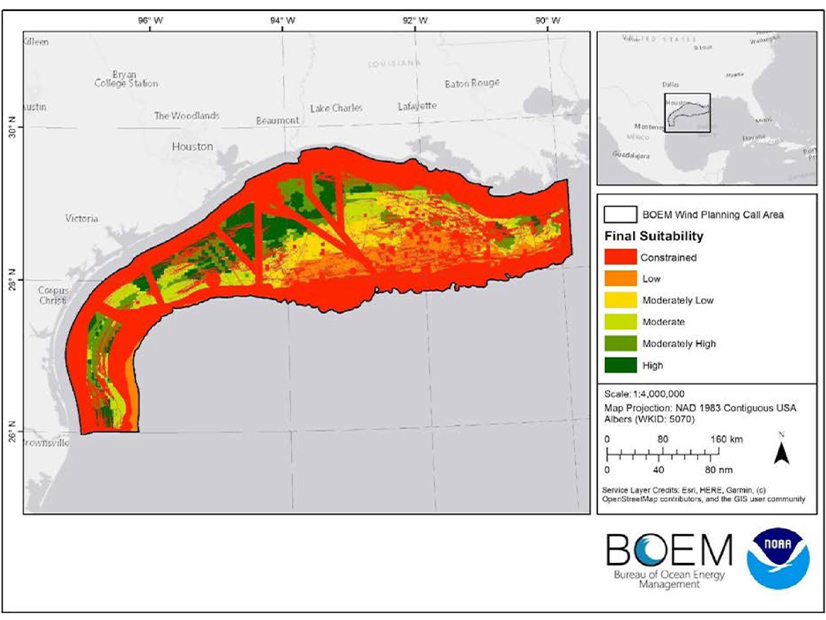
Two new reports examine storms and other obstacles facing offshore wind development in the Gulf of Mexico.
The challenges of siting wind energy generation in the Gulf were highlighted in 2023, when the U.S. Bureau of Ocean Energy Management’s first Gulf offshore wind energy lease drew minimal interest from potential developers. (See Gulf of Mexico Wind Energy Auction Falls Flat.)
However, the Biden administration remains keenly interested in wind energy development in the Gulf, and BOEM this year proposed a second auction, with changes intended to boost bidder interest. (See BOEM Proposes Second OSW Auction in Gulf of Mexico.)
BOEM on May 16 announced release of “Gulf of Mexico Offshore Wind Energy Hurricane Risk Assessment” and “Assessment of Offshore Wind Energy Opportunities and Challenges in the Gulf of Mexico.”
The two new studies are intended to inform local, state and federal strategic renewable energy planning. They are a collaboration by the National Renewable Energy Laboratory, the National Oceanic and Atmospheric Administration’s National Centers for Coastal Ocean Science, Applied Research Associates and CSS.
One of the challenges to siting wind turbines in the Gulf of Mexico is the wind itself, which typically is weaker than in the wind energy development zones off the Atlantic and Pacific coasts — except during the Gulf region’s infamous storms, when the wind can increase to damaging velocity.
NOAA’s historic hurricane mapping system shows 62 hurricanes hitting the Louisiana and Texas coastline in the past century, 18 of them since 2000. There also were 72 tropical storms and 37 tropical depressions in the past 100 years.
The 30-million-acre Call Area designated by BOEM follows the coast from the Mississippi River Delta to the Mexican border. The areas designated for lease so far have been clustered south of the east Texas coast.
“To ensure the robust design of wind turbines in the Gulf of Mexico, it is critical to understand the added risk posed by the threat of major hurricanes,” the hurricane report’s authors write in their executive summary, “because those affecting the Gulf of Mexico region have a significant potential to exceed design limits prescribed by the International Electrotechnical Commission (IEC) wind design standards.”
A problem that immediately presented itself is the mismatch between the data used for the Saffir-Simpson hurricane scale and the IEC design criteria (in which measurements are taken for a much shorter duration at a much greater height above sea level than for Saffir-Simpson).
Also, there are very few detailed measurements of turbulence within hurricanes over the ocean.
IEC standards call for turbines to have a minimum 20-year lifespan and for the return period — the estimated average time between extreme wind events where they are erected — to be at least 50 years.
The authors concluded the 70-meter-per-second 3-second gust specified as the limit for IEC Class 1A turbines would be associated with a strong Category 2 hurricane and have a return period of 20 to 45 years in the Gulf.
The 80-meter-per-second 3-second gust specified for IEC Typhoon Class turbines would be associated with a moderate Category 3 hurricane and have a return period of 40 to 110 years.
“This indicates that the Class 1A limit state may be nonconservative for the entire Gulf of Mexico Offshore Wind Energy area, while the Typhoon Class limit state may be adequate for the design of turbines in some regions,” the report says.
NOAA shows 34 hurricanes rated at Category 2 or worse in the past century along the Texas-Louisiana coastline.
The second report raises another problematic aspect of hurricane winds: their potential to cause construction and operational risks severe enough to give insurers pause. Without insurance, a project is not financeable.
The report says best practices for risk reduction and risk transfer are not established because there is so little operational experience with offshore wind in extreme conditions.
However, some data are beginning to emerge from typhoons in the Taiwanese Strait, and manufacturers are developing hurricane-specific turbine designs. Successful offshore oil and gas substructure designs are informing offshore wind designs.
The Gulf has the opposite problem on the other 364 days of the year, when there is no hurricane: The wind speed is lower than in the Atlantic or Pacific, reducing the gross capacity factor and annual energy output of a turbine while boosting its downstream wind wake effects.
The report states there is no simple engineering solution for designing wind turbines for slower average wind speeds punctuated by dangerously high wind speeds.
On a positive note, the report indicates the shortage of vessels and ports facing offshore wind development elsewhere in the country is less of an issue along the Gulf Coast.
The authors identified nine ports that could support offshore wind and said those that would need upgrades would need less extensive upgrades than ports in other parts of the country.
The authors also identified 25 potential points of interconnection with capacity of at least 230 kV but added that lengthy interconnection queues and other challenges exist in the Gulf region, as elsewhere.



